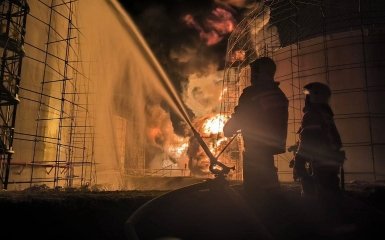In the Liskinsky district of the Voronezh region, a fire at an oil depot that broke out as a result of a drone attack lasted all night. As of this morning, the fight against the fire is ongoing.
Points of attention
- The day before, a drone attack took place on an oil depot in the Liskinsky district of the Voronezh region, causing a fire that has still not been extinguished.
- Fire crews continue to fight fires on several tanks under the threat of repeated attacks.
- The Ukrainian Defense Forces have launched the largest-ever strike on Russian military facilities, hitting targets in the Bryansk, Saratov, Tula regions, and Tatarstan.
- Among the facilities affected by the strikes were an oil depot in Engels (Saratov Region) and a chemical plant in the city of Seltso (Bryansk Region).
- To carry out the strike, Ukrainian units involved the Unmanned Systems Forces, Special Operations Forces, Air Force, and other units.
Oil depot still burning in Voronezh region of Russia
According to the local governor, the territory of three districts of the region was attacked by more than 10 drones at night, most of which struck an oil depot in the Liskin district.
At the initial stage, extinguishing the fire was complicated by the threat of repeated attacks on the facility. Currently, reinforced fire crews are fighting the fire on several tanks: dozens of units of equipment and two fire trains. Additional forces have been sent from two neighboring regions, the Russian governor said.
Ukrainian Defense Forces carried out the largest strike on Russian military facilities
On the night of January 14, the Ukrainian Defense Forces launched the most massive strike against military facilities of the Russian Federation, hitting targets at a distance of up to 1,100 kilometers.
The attacks were carried out on military facilities in the Bryansk, Saratov, Tula regions and the Republic of Tatarstan.
Objects that were hit:
Petroleum products storage facility "Kristal Plant" in Engels (Saratov Region):
The oil depot was attacked by units of the Unmanned Systems Forces and the Main Intelligence Directorate of Ukraine.
The fire, which lasted 5 days after the previous strike, was restored again.
Bryansk Chemical Plant (city of Seltso):
A strategic facility that produces ammunition for artillery, MLRS, aviation, engineering charges, and components for the Kh-59 cruise missile.
A secondary detonation was recorded at the plant, lasting several hours.
Two anti-aircraft missile systems were destroyed - "Tor" and "Buk".
Saratov Oil Refinery:
A blow was struck, which started a large-scale fire.
"Kazanorgsintez" plant (Tatarstan):
The facility was also damaged in the attack, after which a fire broke out.
To accomplish the task, units of the Unmanned Systems Forces, Special Operations Forces, Missile Forces, Air Forces of the Armed Forces of Ukraine, Main Intelligence Directorate of the Ministry of Defense, and Security Service of Ukraine were involved.



